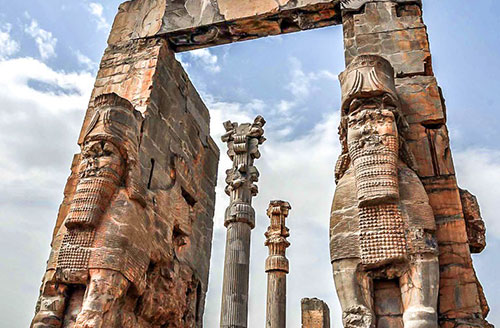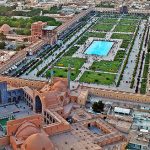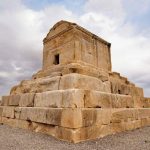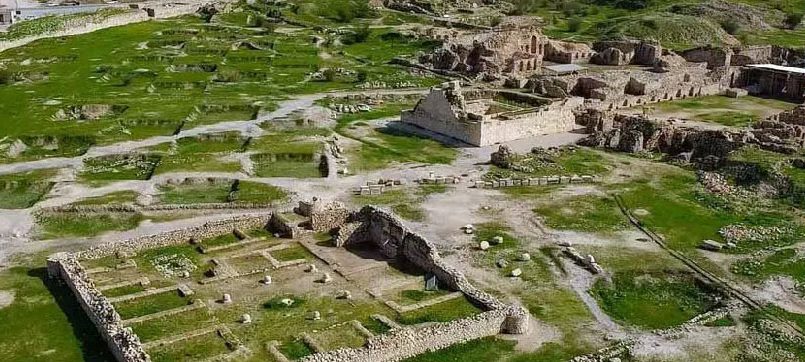Persepolis
In Persian, called /takht-e jamshid/
Persepolis, the ceremonial capital of the Achaemenid Empire in 125,000 square meters, was built by Darius I in the City of Parseh (Persia), 518 B.C. Later, this immense complex was completed (add parts) by his son Xerxes I and his grandson Artaxerxes I. Today, you walk in Persepolis by seven years’ history (from the 4th millennium B.C. to the Safavid Era), while some monuments are under your feet!
The construction of Persepolis never ended.
The Architecture of Persepolis
The Achaemenid artistic styles were inspired by the arts of Assyria, Babylon, and Egypt. But Persepolis head columns and platform-terrace (Sofe) building are unique. Since Persepolis’s terrace was the holy place, people entered without their horses. Persepolis or Takht-e Jamshid had three outer walls: the first wall was 7 meters in height, the second was 14 meters, and the third was 27 meters. The greatness of Persepolis was due to its high walls. Unfortunately, the walls were removed in the first scientific excavations in Persepolis.
Persepolis is 100 times greater than
Assyrian palaces.
The architecture of Persepolis, as one of the great wonders of the ancient world, is sun-dried brick, and buildings were unstable, the bricks destroyed. Persepolis had stone workshops and several stone mines (Majd-Abad and Almas-Bory Mountain in Safashahr), so the gateway, terrace, and window frames were made of stone.
Persepolis has been under construction
for 200 years.
Reliefs in Persepolis
Bas-reliefs in Persepolis are not symbolic but reflect the events that happened. However, all rock reliefs were colored and decorated with gold, today they all disappeared. These bas-reliefs give us a lot of information about the Achaemenid Era. For example, the line of elders (on the right side) and gift-givers (on the left side) while having eggs and colored flowers in his hands indicate Nowruz. It informs us Persepolis was the ceremonial capital used for Nowruz, Mehregan, and Sedeh celebrations. But the king was crowned at Pasargadae.
You can see Horus, gods of Egypt,
on Persepolis’s reliefs.
According to the engraved symbol of Ahura Mazda, an ancient symbol of the Zoroastrian faith (some people mistakenly call it Faravahar), and the inscriptions, the Achaemenids were Zoroastrians. According to Achaemenid beliefs, you rarely see reliefs of the woman in Persepolis. The scarcity of gold coins in Persepolis reveals that people traded goods and gold coins just used for foreign transactions.
The City of Parseh
In the vast ancient city of Parseh, Persepolis was built as a large royal palace on the foot of Rahmat Mountain. The inhabitants of Parseh were the elders, elites, and rich people of Iran, which houses were full of valuable objects. But Alexander the Great deliberately burned this city, massacred elites, and carried off treasures. Today, Persepolis is in Marvdasht, Fars Province.
Burnt curtains are the evidence that Persepoliswas set on fire.
Persepolis or Takht-e Jamshid
In the ancient Greek language, perse means Parseh, and polis means the city. Persepolis is a translation of a Greek compound word that equals the City of Persia. In 590 A.H, after composing the Shahnameh, the name of Takht-e Jamshid (the throne of Jamshid) was founded. The Sassanid called it Sad-Sotun (hundred pillars), and Safavid named it Chehel-Monar (forty minarets). If you travel to Persepolis, you will find memories of Sir John Malcolm and James Moreau on Persepolis’s columns.
The Important Parts of Persepolis, A Symbol of Iran All Over the World
Entrance Stairs: At the entrance of this magnificent complex, there are double stairways in symmetry with 111 short stone steps leading to the entrance gate. The staircase is decorated amazingly to Persians could ascend the 111 steps gracefully in long elegant robes.
Gate of All Nations: The great gate built in the reign of Xerxes I, who named it his Gate of All Nations or Xerxes’ Gateway, the big waiting room for different nations with three main entrances. Each entrance was used for its performance: the first doorway led to Apadana Palace, another one belonged to the guards. Reliefs in this masterpiece gate are influenced by the Assyrians and show two enormous winged bulls with human faces (lamassu). But unlike Assyrian five-legged bulls, these bulls are closer to nature. You can see the accuracy of the reliefs by looking at the bull’s veins and muscles. The gate is decorated with cuneiform inscriptions in Old Persian (in the middle), Babylonian (on the left), and Elamite (on the right) languages. All said: My father built the city, but I (Xerxes I) built the Gate of All Nations. Griffins (in the logo of Iran air) are another well-known carving near the gate.
Apadana Palace: Gold and silver inscriptions in Apadana show that Apadana Palace was the most important building in Persepolis. Constructing Apadana started during Darius the Great and finished in the reign of Xerxes after 30 years.
The Apadana columns are 19 meters in height
and the main door is 15 meters in height,
which is covered with gold!
The Palace has a 3600 square central hall with 36 columns, three porches (in the north, east, and west) with 12 columns on each porch (Ivan), four towers, several guardrooms, an L-shaped courtyard, and two stairways with amazing bass reliefs and ornaments. There is no south porch, and the south side of Apadana Palace leads to Tachra Palace and Soldier House. The columns and towers were topped by sculptures of various animals such as the bull, lion, and dog. Apadana, as the heart of Persepolis, was where that the king received foreign delegations.
Ten thousand people could attend
in the central hall simultaneously.
If you stick the bas reliefs in Apadana double-reversed stairways together, you will find a complete man! Bas reliefs in Apadana stairways are the most splendid parts of Persepolis. You can see the reliefs of gift-givers from 23 nations, flowers (sunflower and chamomile that show spring growth), Persian nobility, the Imperial Guard, the Immortals in Apadana stairways. Each relief tells a story from the Achaemenids Period, and the reliefs are so precise in details.
In the reliefs of Apadana stairways, the Medes are wearing suits.
It is interesting to know that
the first nation that wore suits in the world was Iranian.
Tachar Palace: Darius Private Palace or Tachar Palace, as a private winter palace, is one of the first palaces built on the orders of Darius I. All the Persepolis palaces are one-floor buildings, and only its towers are three floors. Tachar, as the best-preserved palace in Persepolis, has inscriptions of the Sassanid period. Ardashir changed the architecture of Tachra Palace, and some inscriptions do not belong to this palace.
The oldest frescoes are
Found in Tachar.
As reliefs showed, this private palace is the king’s resting palace and has a bathhouse (some people have towels in their hands). According to body anatomy, Tilia said the servant with a towel on her hand is a woman. The palace opens onto a royal courtyard with two palaces.
Hadish Palace: Xerxes Private Palace or Hadish Palace is located to the east, and two double reversed staircases are decorated in reliefs. Ornaments and crown matched to the bas-reliefs. The palace opens onto Three Gates (se darvaze).
The pillars of Hadish made of wood
and were burnt on fire.
Central Palace: Central Palace, also known as the Three Gates Palace and Shura Palace, was used for high-ranking officials’ meetings and consultations, in the center of the Persepolis. The palace connects to other buildings through three gates, a couple of corridors, and staircases. The most beautiful reliefs of Persepolis are in the stairway of the Shura Palace. The stone solar watch is on the door of the Central Palace, and Achaemenid finds the calendar through the sunlight that comes from Rahmat Mountain. The doors and pillars were made of wood and burnt in the fire.
Sad Sotun Hall: Hundred-Column Hall or Throne Hall is located east of the Apadana and the north of the Treasury as the second-largest palace of Persepolis. The Throne hall (also known as Palace of 100 Columns or Hall of 100 Columns) was begun by Xerxes I and finished by his son Artaxerxes I. The central hall of 100 Columns Palace is bigger than Apadana, with 100 fourteen-meter-high stone columns in 4200 square meters. Some believe Sad Sotun Hall was built as one of the reception areas in Persepolis, and some think the hall was used to receive the military elite. Bas-reliefs in this huge palace show man‘s fight a lion (here, we can see the battle of the king against the lion), a king, soldiers, and representatives.
H palace: The remains of an unfinished palace in the south of Persepolis is known as H Palace. The palace has two stairs decorated with reliefs (two groups of 16 Persian soldiers standing on two sides of a Persian inscription). Ardashir III added these stairs to Palace H.
J palace: To the south of the Apadana Palace, the remains of a tall building known as Palace J. Some people mistakenly call it the Holy Land because of its location in a high place. But the palace was the infrastructure of a royal palace (like Tachra). J Palace has changed during the time of Ardashir III.
The Tombs: Six rock-hewn tombs left of the Achaemenid kings, four of which are in the Naqsh-e Rostam. Two are on the hill above the Persepolis Treasury: Tomb of Artaxerxes II and tomb of Artaxerxes III. The Architecture of tombs imitated the tomb of Darius the Great. It’s impossible to enter the tombs, and you can see their remarkable bas-relief depictions. Darius III’s unfinished tomb is in the southwestern valley of Persepolis.
Treasury Palace: Darius has built Treasury as the administrative part of Persepolis in the southeastern corner of the site. And Xerxes extended it to Harem and Treasury. The map’s building, as one of the earliest structures at Persepolis, has been constantly changed.
Archaeologists have found stone tablets detailing
the travelers and animal rations
and wages of thousands of workers.
Treasury housed gifts from different nations, government archives, booty taken in conquest, religious work, stone tables, and artworks.
Harem of Xerxes: Harem or Queen’s Palace was the first building Xerxes built on a natural bedrock west of the treasury. This L-shaped building is decorated with a relief of Xerxes I while wearing informal clothes. Krefter has restored part of this building for the residence of the archeological group in the 1930s. The palace is now the Persepolis Museum and administrative offices.
Persepolis Museum: Persepolis Museum or Achamenied Museum, as part of the Royal Harem, is the oldest museum building in Iran. The museum contains valuable inscriptions and artifacts discovered from excavations, such as king’s clothes with delicate needle designs, the oldest tie in Iran, wood shields, alabaster vessels, and lances and arrow tips.
The stone well at 40 meters depth, the chariot road, Hall of 32 Columns as Artaxerxes III Palace, the unfinished gate as a larger version of the Gate of All Nations, Royal Gardens, gardens as a zoo, soldier house, and Warehouses are other parts of Persepolis Complex. Also, Sassanid columns (related to the city of Estakhr), the relief of Pazirik Carpet, the inscription of Ibrahim Mirza (Timurid), the inscription of Amin Al-Dawlah, and the inscription of Samsam Al-Dawlah (a person who fills the Estakhtr with water) are in Persepolis.






